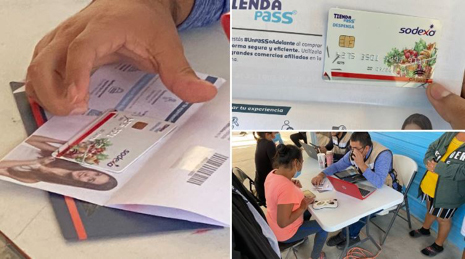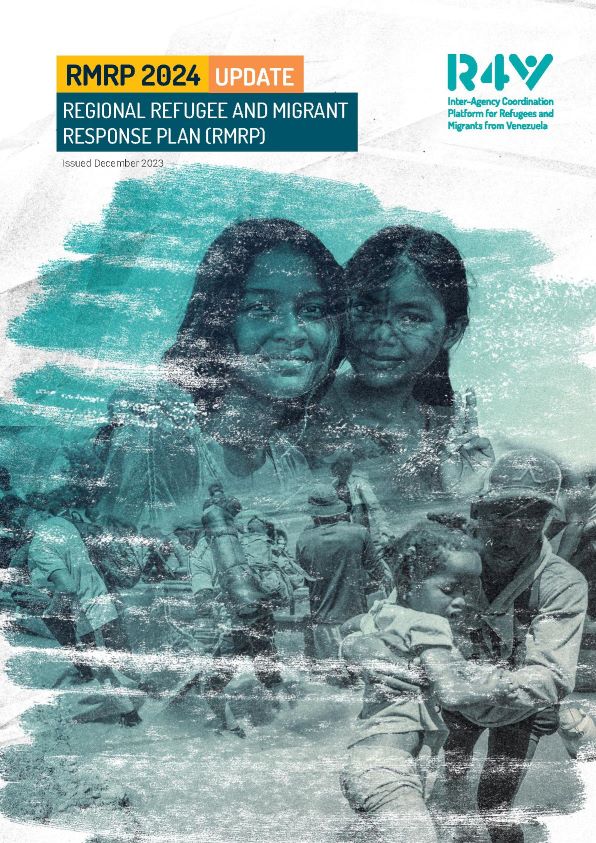Biden Admin. Sends Millions to Religious Nonprofits Facilitating Mass Illegal Migration
UN-provided debit cards issued to immigrants in Reynosa, Mexico, in late 2021. Photo by Todd Bensman.
By Todd Bensman
AUSTIN, Texas — As the Center for Immigration Studies recently reported, a United Nations-led “Regional Refugee and Migrant Response Plan (RMRP)” calls for more than 200 nonprofit groups to dole out $1.6 billion in cash debit cards, food, clothing, medical treatment, shelter, and even “humanitarian transportation” during 2024 to millions of U.S.-bound immigrants in 17 Latin American nations and Mexico.
But suspicions that the administration of President Joe Biden is directly footing the bill for at least part of facilitating the most voluminous mass migration crisis in U.S. history, now in its fourth straight year, can now be confirmed.
A follow-up CIS examination of the more than 30 faith-based nonprofits among those UN NGO partners — representing Jewish, Lutheran, Seventh Day Adventist, Catholic, and nondenominational evangelical organizations — shows that the U.S. State Department’s Bureau of Population, Refugees, and Migration (PRM) and the U.S. Agency for International Development (USAID) have been mainlining taxpayer funds to these groups, which then distribute them to keep hundreds of thousands of migrants comfortably moving toward illegal U.S. southern border crossings.
HIAS. A prime example is the self-described “Jewish American” nonprofit organization HIAS of Silver Spring, Md. (incorporated in 1903 as the Hebrew Immigrant Aid Society), which has pledged $17.1 million in aid to immigrants in at least seven Latin American nations during 2024, the UN’s RMRP planning documents show. It turns out that in FY 2022, 47 percent of revenue reported by HIAS came as grants from government agencies, the majority from the State Department, but some also from the Department of Homeland Security, according to the group’s tax filings and other sources, with the balance coming from a mix of major corporate sponsors and other sources.
But there can be little question about the origins and purpose of at least some of HIAS’s $17 million pledge to the UN’s Latin America migrant trails project. Last year, the State Department’s PRM gave HIAS a $6 million grant for it, according to USAspending.gov, a database that tracks federal spending.
The first infusions of another $5.2 million State Department PRM grant to HIAS this year — explicitly for the UN endeavor in Latin America — started arriving in September 2023 with the last of it to come in September of this year, according to USAspending.gov.
All $11 million was earmarked to HIAS by the State Department’s overseas refugee assistance programs for the Western Hemisphere, which the UN plan aims to support through “direct emergency humanitarian assistance such as food, non-food items, shelter, health, psychosocial support” in major migration transit countries like Colombia, Ecuador, and Peru.
A UN “activity explorer” database of the participating NGOs shows that some $6.1 million of 2024’s HIAS commitment will go out as cash cards, cash vouchers, and cash in-kind services while most of the rest goes to humanitarian transportation, food, shelter, and various services.
Record Taxpayer Support of UN Spearheading Agencies
UN budget documents, federal grant-tracking databases, and other public sources show that the State Department’s PRM and USAID also have poured taxpayer money into at least the other religion-oriented NGOs that CIS selected for examination, including Catholic, Lutheran, and Seventh Day Adventist groups. The list of participating NGOs comes from the UN’s 2023-2024 Regional Refugee and Migrant Response Plan (RMRP), which lists more than 200 of the groups on p. 268.
The Center for Immigration Studies has exported that list here to make it available for further public study. Another 20 new NGO groups signed on for the coming year, although they are not readily identified.
But the State Department and USAID also sent historic volumes of cash to the Latin America project’s main United Nations overseers, which also pass that aid straight to migrants: the UN High Commissioner for Refugees (UNHCR) and the International Organization of Migration (IOM).
The State Department’s PRM has given IOM $1.4 billion in just the last 12 months, by far the most on record, according to USAspending.gov, a database that tracks federal spending. It is also the biggest donor to UNHCR, which is among 15 different UN agencies that will spread money and aid all along the migrant trails of Latin America. This is part and parcel of a State Department agreement to a “2023-2025 Framework for Cooperation” with the UNHCR to pay into the effort and to politically support its goals. The State Department openly acknowledges issuing guidance to field staff on budget and planning coordination for the Latin American effort, and it has turned over operation of major U.S. government policy initiatives in Latin America, such as an expansion of “refugee” centers and management of a no-interest “international travel loan” programs.
The State Department’s PRM, USAID, and UN agencies all see this straight-line pass-through of American taxpayer assistance with “multilateral organizations” as “social and economic protection and risk reduction” for vulnerable stateless people “forced” to flee home countries, as the 2023 PRM grant to HIAS put it.
“PRM promotes U.S. interests by providing protection, easing suffering, and resolving the plight of persecuted and forcibly displaced people around the world,” the State Department’s PRM website explains.
But a more critical interpretation of such direct Biden government infusions of taxpayer money — and operational closeness with the UN agency recipients — is that it hurts the country by easing the northward path for mainly economic immigrants who voluntarily make the journey knowing in advance that all of their basic needs will be provided for and that border policies virtually guarantee their entry and long-term stay.
The funding intervention raises the specter that Biden administration appointees in these government agencies, many hailing from NGOs like HIAS, engineered the catch-and-release policies that initially triggered the mass migration crisis in 2021, then arranged for taxpayer money to support the flows. (HIAS publicly lauded the 2021 nomination of DHS Secretary Alejandro Mayorkas, who served as a HIAS board member.)
Some Republicans have proposed legislation to halt U.S. funding of the UN agencies and their NGO partners, but short of illumination about how it all works, the legislation has gained no traction.
“This is a slap in the face to American taxpayers who foot the bill for this corrupt globalist institution,” Texas Rep. Lance Gooden said last year. “Republicans must condition UN funding and stop this taxpayer funded invasion immediately.”
In God They Really Trust
The UN has entrusted faith-based establishment NGOs with handling a lot of the $372 million in “Cash and Voucher Assistance” and “Multipurpose Cash Assistance” the broader endeavor will hand out to an estimated 624,000 migrants “in-transit” to the United States during 2024. That money is most often handed out, other UN documents show, as pre-paid, rechargeable debit cards, but also hard “cash in envelopes”, bank transfers, and mobile transfers that the U.S. border-bound travelers can use for whatever they want.
The Jewish group is hardly alone among faith-based NGOs essentially passing through U.S. taxpayer money to immigrants in just these ways.
Adventists. The Seventh-day Adventist Church’s “global humanitarian arm”, the Silver Spring, Md., Adventist Development and Relief Agency (ADRA), plans to distribute more than $10 million, nearly 38 percent of it as cash and cash vouchers and the rest as food, shelter, and hygiene needs in Brazil, Colombia, Ecuador, Argentina, and Peru.
ADRA received significant funding from USAID and the State Department from 2021-2023, nearly $51 million in 2021, $32 million in 2022, and more than $9 million in 2023 and two unspecified grants so far for 2024, according to USAspending. It’s unclear how much of that is earmarked for U.S.-bound immigrants in Latin America, but clearly some of it will be in 2024. Brazil and Honduras were among the top countries where ADRA spent money.
Organizations associated with the Catholic Church, collectively, move among the largest volumes of cash and other aid into the hands of U.S.-bound foreign nationals, more than $26 million. Three Jesuit-associated groups are to move some $5.3 million into immigrant hands, while the Catholic Commission for Social Justice sends out nearly $2 million.
Catholics. The highly visible Catholic Charities USA is not on the list of those working south of the border with this UN project, although the NGO and its many affiliate components receive tens of millions of dollars in federal awards to manage illegal immigrant transportation north from the border and resettlement activity in the United States interior.
But some 13 franchises of the nonprofit Caritas, whose website states that it is “inspired by the Catholic faith” and is “the helping hand of the Church”, will dole out $12.3 million to immigrants south of the border, much of it as cash and cash vouchers, the activity explorer search tool shows.
USAID and the State Department’s PRM have given more than $11 million to one of them, Caritas Brazil, since the mass migration began in 2021, including $3 million pledged through December 2024 “overseas refugee assistance programs for the Western Hemisphere” that include “food, non-food items, shelter, health, [and] psychosocial support”, USAspending shows here and also here.
By way of explaining its views on this aid, Caritas Switzerland, one of the most giving of the 13 franchises, says on its website that migration “globally across international borders in non-regulated forms … represents a legitimate strategy of people to improve their lives”.
No matter that UN-member nations along the way don’t want this traffic coursing through their territories. Caritas is going to “cover basic needs, such as food, personal hygiene products, clean clothes, safe decent accommodation and subsidized transport”.
Other faith-based NGOs representing Christian denominations are well represented and also funded, in part, directly by the U.S. treasury.
Lutherans and More. In FY 2023, USAID awarded Lutheran World Relief a million-dollar grant for this year. The group would hand off about $181,000 supporting immigrants in Latin America.
USAID in recent years has given the nondenominational Boone, N.C., Samaritan’s Purse $29 million “for programs overseas”, albeit much of it for activities in Africa. But Samaritan’s Purse has pledged $718,513 to the UN project in Latin America.
About the Rest
The 200-plus NGOs are listed for their activities south of the U.S. border, although some, like HIAS, also support immigrants inside the United States whom they have already helped cross. The list of these groups do not include a burgeoning number of large and small NGOs that work mainly inside the United States providing, for instance, transportation into the interior as well as shelter, food, housing, and many other resettlement needs and wants.
This examination of some of the religion-oriented NGOs indicates probable Biden government taxpayer support for many more of the others. But pending further research, the extent of tax money diversion to them is not publicly known.
The UN plan lists 57 as “international NGOs” like HIAS and ADRA, but also 132 “national NGOs”, probably indigenous to foreign countries. Further investigation would need to determine whether the State Department and USAID send pass-through money to these. The plan also names a mysterious category of “Others” such as the Red Cross Movement and “academia”.
Language in the UN plan for Latin America in 2024 leaves no doubt that its architects in both the UN and U.S. agencies are in lockstep about one thing: aggressively expanding the ranks of NGOs working on the migration trails, which if logic follows, would portend even greater diversions of U.S. taxpayer money to support them.







